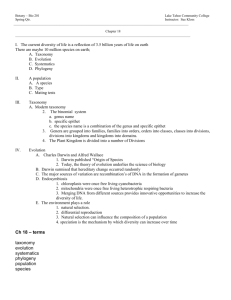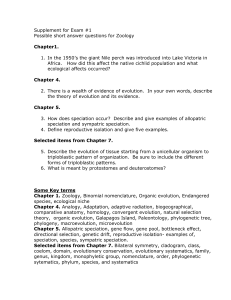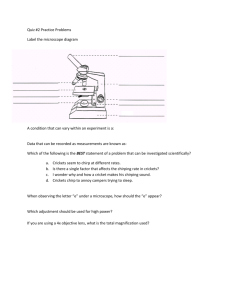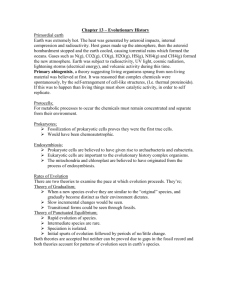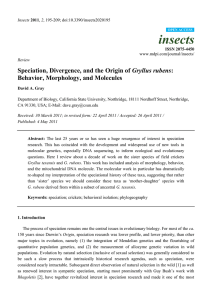Evolution Unit Study Guide
advertisement
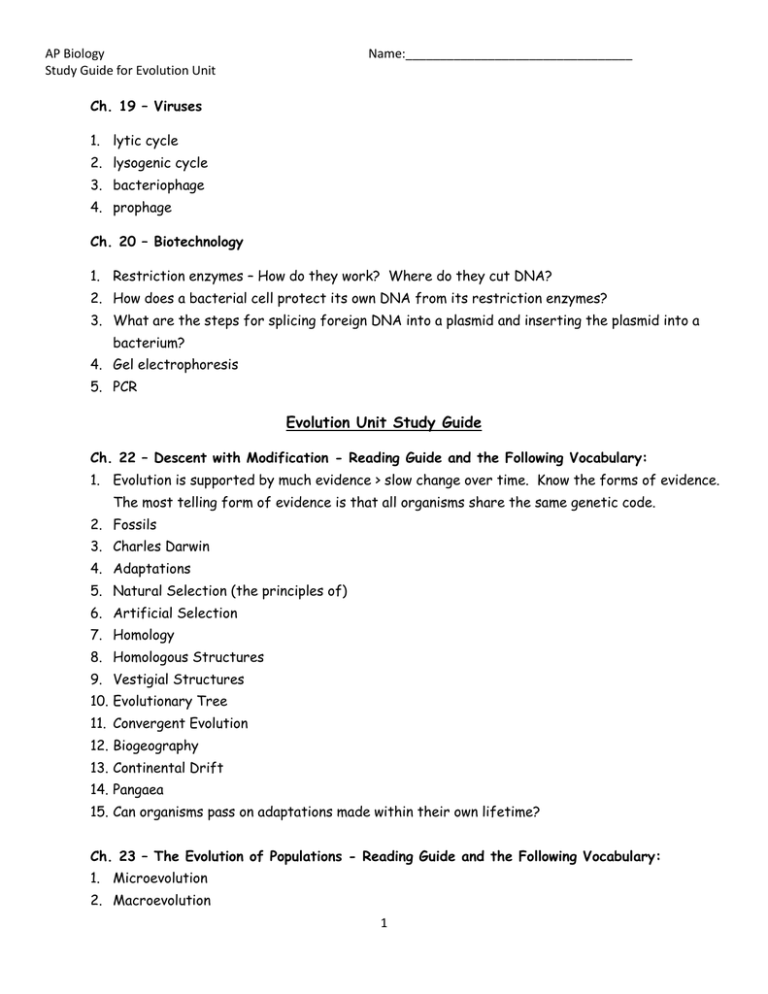
AP Biology Study Guide for Evolution Unit Name:_________________________________ Ch. 19 – Viruses 1. lytic cycle 2. lysogenic cycle 3. bacteriophage 4. prophage Ch. 20 – Biotechnology 1. Restriction enzymes – How do they work? Where do they cut DNA? 2. How does a bacterial cell protect its own DNA from its restriction enzymes? 3. What are the steps for splicing foreign DNA into a plasmid and inserting the plasmid into a bacterium? 4. Gel electrophoresis 5. PCR Evolution Unit Study Guide Ch. 22 – Descent with Modification - Reading Guide and the Following Vocabulary: 1. Evolution is supported by much evidence > slow change over time. Know the forms of evidence. The most telling form of evidence is that all organisms share the same genetic code. 2. Fossils 3. Charles Darwin 4. Adaptations 5. Natural Selection (the principles of) 6. Artificial Selection 7. Homology 8. Homologous Structures 9. Vestigial Structures 10. Evolutionary Tree 11. Convergent Evolution 12. Biogeography 13. Continental Drift 14. Pangaea 15. Can organisms pass on adaptations made within their own lifetime? Ch. 23 – The Evolution of Populations - Reading Guide and the Following Vocabulary: 1. Microevolution 2. Macroevolution 1 AP Biology Study Guide for Evolution Unit Name:_________________________________ 3. Mutation 4. Population 5. Gene Pool 6. Hardy-Weinberg Principle (equilibrium) 7. Genetic Drift a. Founder Effect b. Bottleneck Effect 8. Gene Flow 9. Relative Fitness 10. Directional Selection 11. Disruptive Selection 12. Stabilizing Selection 13. Sexual Selection 14. Heterozygote Advantage Ch. 24 – The Origin of Species - Reading Guide and the Following Vocabulary: 1. Speciation 2. Species 3. Reproductive Isolation 4. Hybrids 5. Prezygotic Barriers – see chart in guided notes 6. Postzygotic Barriers – see chart in guided notes 7. Allopatric Speciation 8. Sympatric Speciation 9. Polyploidy 10. What is the main cause of genetic variation in humans? Ch. 25 – History of Life on Earth - Reading Guide and the Following Vocabulary: 1. Protobionts 2. Ribozymes 3. Radiometric Dating 4. Half-life 5. Cyanobacteria 6. Endosymbiosis 7. Serial Endosymbiosis 8. Mass Extinction 2 AP Biology Study Guide for Evolution Unit Name:_________________________________ 9. Adaptive Radiation 10. Hox Genes 11. What was early Earth’s atmosphere like? Which gas did not yet exist? 12. What did Miller and Urey discover? 13. What are the sequences of events in the origin of life? 14. What was the first hereditary information? 15. How far back does the fossil record extend? Ch. 26 – Phylogeny - Reading Guide and the Following Vocabulary: 1. Phylogeny 2. Systematics 3. Binomial Nomenclature 4. Genus 5. Species 6. Phylogenetic Tree 7. Taxonomy 8. Cladistics 9. Clade 10. Shared Ancestral Character 11. Shared Derived Character 12. Outgroup 13. Ingroup 14. Biochemical evidence for evolution – DNA and amino acid sequences Resources: Chapter Reading Guides POGIL Worksheet Packets: - Chi-Square Analysis - Hardy Weinberg Equation - Selection and Speciation (Parts I and II) - Phylogenetic Trees www.BozemanScience.com: View all podcasts under Big Idea #1 – Evolution 3 AP Biology Study Guide for Evolution Unit Name:_________________________________ Possible Free Response Questions: 1. The frequency of the sickle cell disease in parts of Central Africa is as high as 11% compared to a frequency of 0.6% in the US. (This is a 10 pt. question.) a. Why are the frequencies of these traits different in these two areas? Explain why and how these differences are possible? b. Use the percentage for the western Africa population and the US population to calculate the frequency of the heterozygous and homozygous dominant genotypes in each of these areas. c. Is there evidence of heterozygote advantage in either one of these populations? Explain the evidence or lack of. 2. The most supported theory about how the first eukaryotic cells evolved from prokaryote ancestors is through a process called serial endosymbiosis. (This is a 10 pt. question.) a. Explain the process of serial endosymbiosis. b. Explain the evidence for serial endosymbiosis. c. There are three domains of life. Draw a phylogeny that shows the evolutionary relationships of these three organisms. d. Explain the phylogeny and the common ancestor of these three domains. 3. A population of crickets feeds on two species of weedy plant (A and B). Both plants are spread across the habitat range of this population. There aren’t any physical barriers to prevent crickets from moving between the plants. After many generations, the crickets that were born on plant A have begun to only eat plant A and mate with other plant A crickets. The crickets born on plant B have begun to eat only plant B and mate with only plant B crickets. (This is a 4 pt. question.) a. Is there evidence for speciation on this population? Explain the evidence. b. Is this an example of sympatric or allopatric speciation? Explain your response. c. What kinds of isolating mechanisms are present in this population? 4. Natural selection is the major mechanism for evolution as described in the Origin of Species by Charles Darwin. (This is a 4 pt. question.) a. Explain evolution by natural selection. b. Use one of the following examples to explain the process of natural selection: i. Finches on the Galapagos Islands ii. Armadillos and giant armadillo-like mammals iii. Standard sloths and extinct giant sloths iv. Horses and zebras 5. One theory for the evolution of the first organic macromolecules like proteins, carbohydrates, and lipids is called chemical evolution. In this theory, explain how the small inorganic molecules in the atmosphere could lead to organic macromolecules. (This is a 2 pt. question.) 4





